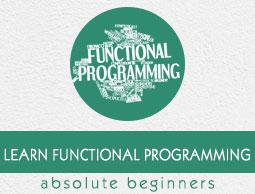Functional Programming - Data Types
A data-type defines the type of value an object can have and what operations can be performed on it. A data type should be declared first before being used. Different programming languages support different data-types. For example,
- C supports char, int, float, long, etc.
- Python supports String, List, Tuple, etc.
In a broad sense, there are three types of data types −
Fundamental data types − These are the predefined data types which are used by the programmer directly to store only one value as per requirement, i.e., integer type, character type, or floating type. For example − int, char, float, etc.
Derived data types − These data types are derived using built-in data type which are designed by the programmer to store multiple values of same type as per their requirement. For example − Array, Pointer, function, list, etc.
User-defined data types − These data types are derived using built-in data types which are wrapped into a single a data type to store multiple values of either same type or different type or both as per the requirement. For example − Class, Structure, etc.
Data Types Supported by C++
The following table lists the data types supported by C++ −
| Data Type |
Size |
Range |
| char |
1 byte |
-128 to 127 or 0 to 255 |
| unsigned char |
1 byte |
0 to 255 |
| signed char |
1 byte |
-128 to 127 |
| int |
4 bytes |
-2147483648 to 2147483647 |
| unsigned int |
4 bytes |
0 to 4294967295 |
| signed int |
4 bytes |
-2147483648 to 2147483647 |
| short int |
2 bytes |
-32768 to 32767 |
| unsigned short int |
2 bytes |
0 to 65,535 |
| signed short int |
2 bytes |
-32768 to 32767 |
| long int |
4 bytes |
-2,147,483,648 to 2,147,483,647 |
| signed long int |
4 bytes |
-2,147,483,648 to 2,147,483,647 |
| unsigned long int |
4 bytes |
0 to 4,294,967,295 |
| float |
4 bytes |
+/- 3.4e +/- 38 (~7 digits) |
| double |
8 bytes |
+/- 1.7e +/- 308 (~15 digits) |
| long double |
8 bytes |
+/- 1.7e +/- 308 (~15 digits) |
Data Types Supported by Java
The following data types are supported by Java −
| Data Type |
Size |
Range |
| byte |
1 byte |
-128 to 127 |
| char |
2 byte |
0 to 65,536 |
| short |
2 byte |
-32,7688 to 32,767 |
| int |
4 byte |
-2,147,483,648 to 2,147,483,647 |
| long |
8 byte |
-9,223,372,036,854,775,808 to 9,223,372,036,854,775,807 |
| float |
4 byte |
-2147483648 to 2147483647 |
| double |
8 byte |
+9.223*1018 |
| Boolean |
1 bit |
True or False |
Data Types Supported by Erlang
In this section, we will discuss the data types supported by Erlang, which is a functional programming language.
Number
Erlang supports two types of numeric literals, i.e. integer and float. Take a look at the following example that shows how to add two integer values −
-module(helloworld).
-export([start/0]).
start() ->
io:fwrite("~w",[5+4]).
It will produce following output −
9
Atom
An atom is a string whose value can’t be changed. It must begin with a lowercase letter and can contain any alphanumeric characters and special characters. When an atom contains special characters, then it should be enclosed inside single quotes ('). Take a look at the following example to understand better.
-module(helloworld).
-export([start/0]).
start()->
io:fwrite(monday).
It will produce the following output −
monday
Note − Try changing the atom to "Monday" with capital "M". The program will produce an error.
Boolean
This data type is used to display the result as either true or false. Take a look at the following example. It shows how to compare two integers.
-module(helloworld).
-export([start/0]).
start() ->
io:fwrite(5 =< 9).
It will produce the following output −
true
Bit String
A bit string is used to store an area of un-typed memory. Take a look at the following example. It shows how to convert 2 bits of a bit string to a list.
-module(helloworld).
-export([start/0]).
start() ->
Bin2 = <<15,25>>,
P = binary_to_list(Bin2),
io:fwrite("~w",[P]).
It will produce the following output −
[15,25]
Tuple
A tuple is a compound data type having fixed number of terms. Each term of a tuple is known as an element. The number of elements is the size of the tuple. The following example shows how to define a tuple of 5 terms & prints its size.
-module(helloworld).
-export([start/0]).
start() ->
K = {abc,50,pqr,60,{xyz,75}} ,
io:fwrite("~w",[tuple_size(K)]).
It will produce the following output −
5
Map
A map is a compound data type with a variable number of key-value associations. Each key-value association in the map is known as an association-pair. The key and value parts of the pair are called elements. The number of association-pairs is said to be the size of the map. The following example shows how to define a map of 3 mappings and print its size.
-module(helloworld).
-export([start/0]).
start() ->
Map1 = #{name => 'abc',age => 40, gender => 'M'},
io:fwrite("~w",[map_size(Map1)]).
It will produce the following output −
3
List
A list is a compound data type having variable number of terms. Each term in the list is called an element. The number of elements is said to be the length of the list. The following example shows how to define a list of 5 items and print its size.
-module(helloworld).
-export([start/0]).
start() ->
List1 = [10,15,20,25,30] ,
io:fwrite("~w",[length(List1)]).
It will produce the following output −
5
Note − 'String' data-type is not defined in Erlang.


